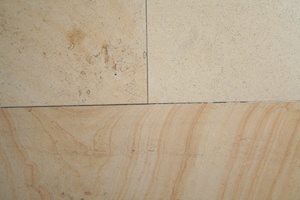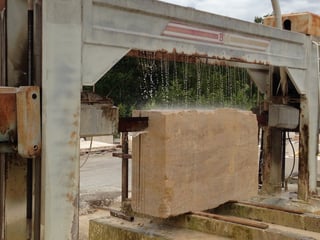Choosing Natural Stone for projects
The three important things that clients tend to overlook:
I was asked, recently, to present a seminar to members of the Stone Federation of Great Britain as part of the regular training that the members undergo. One section of my talk focussed on three of the main questions that are asked of the Stone Federation's technical help line.
The Stone Federation of Great Britain operates a technical help line that will be of interest to architects, interior and landscape designers and anyone else involved in specifying natural stone for commercial and residential projects. One of the benefits of being a member is that you can get any technical questions answered by the country's leading stone experts. The Stone Federation has a section that Architects and Designers can join so that they also benefit from the UK's leading natural stone experts. Give them a call on 01303 856123 to find out more or visit http://www.stonefed.org.uk/.
The technical committee is asked many different questions that cover a huge range of topics relating to natural stone but here are three of the more common ones.
Question 1:
"Why doesn't the delivered stone match the sample I saw?"
This question usually arises up when a delivery of stone arrives on site and the colouring and veining or fossil content doesn't appear to match up with the small sample that the customer saw. Often, it's because the sample wasn't large enough to incorporate all the different shades and patterns that are natural in the chosen stone.
 This is best explained by looking at the image here. It shows three tiles of the same French limestone laid next to each other on a beautiful stone floor. If you only saw a small sample from any one of the three tiles, you would not be able to guess what the whole floor would look like. These three tiles together could represent the range of variation that might be delivered but, individually, it would be impossible to predict the colour, veining or fossil content of the rest of the floor.
This is best explained by looking at the image here. It shows three tiles of the same French limestone laid next to each other on a beautiful stone floor. If you only saw a small sample from any one of the three tiles, you would not be able to guess what the whole floor would look like. These three tiles together could represent the range of variation that might be delivered but, individually, it would be impossible to predict the colour, veining or fossil content of the rest of the floor.
It's even harder with many marbles that have large, bold veins and colour differences across a single slab.
So, the answer to this first question would be:
- Don’t rely on ‘coaster’ sized samples.
- Look at large slabs if possible.
- Better still, visit the quarry or processing factory to see the range variation.
- As a minimum, look at samples and photos of all the different variations that can be expected from the current production.
Remember, it's a natural product and subject to natural variations. Make sure you know what to expect.
No surprises!
Question 2:
"Why are larger tiles more expensive than small ones?"
The price per square metre of small tiles, say 30x30cms, is often significantly less than the square metre price of larger tiles, say 60x60cms. Why is it?
 The simple answer is that it is down to the amount of waste generated as only a certain percentage of the block can be used to produce the tiles. Imagine that the average size of a block is 2m wide x 1m high x 1m deep and the quarry wants to cut 60x60cm tiles from this block. The actual size of the block that is quarried depends on many different factors; the bed size, the size of the saw, the carrying capacity of the transport vehicles etc.
The simple answer is that it is down to the amount of waste generated as only a certain percentage of the block can be used to produce the tiles. Imagine that the average size of a block is 2m wide x 1m high x 1m deep and the quarry wants to cut 60x60cm tiles from this block. The actual size of the block that is quarried depends on many different factors; the bed size, the size of the saw, the carrying capacity of the transport vehicles etc.
Assuming that the blocks are 2 x 1 x 1 metres as our example, in many quarry factories, the block is first cut into slabs 2m wide x 1m high. These slabs are then cut to the required size of 60cms x 60cms. In this example, from each slab, the quarry can cut just 3 tiles which means that almost 50% of the slab is unused. If they cut 30x30cm tiles, there would only be around 20% wastage.
This leads us to ask the question, "How can we get a more efficient use of the block and therefore get a better price?"
 One way would be to specify a tile size of, say, 40cm x Random Length. This sizing is sometimes called "running lengths" or "free lengths". We specify the width of the tiles as 40cms and leave the length to be decided by the quarry so that they can make the most efficient use of the block. In this example, the customer would get some pretty large tiles, typically varying from 40x60cms up to 40x100cms, and only about 20% of the block would be unused. This also allows the quarry to avoid any natural defects in the block without having to discard large sections. If the length of the tile can be variable, it can be trimmed a little shorter but it is still saleable and usable. Hence, the quarry gets to sell more of the block and therefore doesn't have to put a premium onto the price to keep it viable.
One way would be to specify a tile size of, say, 40cm x Random Length. This sizing is sometimes called "running lengths" or "free lengths". We specify the width of the tiles as 40cms and leave the length to be decided by the quarry so that they can make the most efficient use of the block. In this example, the customer would get some pretty large tiles, typically varying from 40x60cms up to 40x100cms, and only about 20% of the block would be unused. This also allows the quarry to avoid any natural defects in the block without having to discard large sections. If the length of the tile can be variable, it can be trimmed a little shorter but it is still saleable and usable. Hence, the quarry gets to sell more of the block and therefore doesn't have to put a premium onto the price to keep it viable.
Question 3:
"Why would a highly slip resistant tile be more difficult to keep clean?"
Slip resistance is an important consideration particularly when specifying flooring in public, commercial or wet areas. Even in domestic and residential areas such as bathrooms or around swimming pools, the specifier has to be mindful of the potential for accidents. Adding a texture to the surface of the stone can improve the slip resistance and reduce the chances of someone slipping and injuring themselves. But, adding a texture can also mean that the surfaces become more difficult to keep clean. A smooth surface will always be easier to keep clean whereas dirt can be trapped and held by a rougher surface.
Tiles/slabs that might be walked on and get wet should be tested to give SRV (slip resistance value) of at least 36. Tests show that slips are less likely with a higher slip resistance value. If the tiles or slabs are on an incline, then it may be sensible to increase the SRV a little further.
There's a balancing act (sorry, didn't intend the pun) between slip resistance and ease of maintenance.
One other point to consider with regard to slip resistance is how the stone will wear over time. A fine grained stone can be mechanically textured to give a high SRV rating but after a few years of wear, the rating can decrease as the stone is worn smooth. In high traffic areas, it would be worth considering using a dense but coarser grained stone that tends to to have a naturally higher SRV.
Click for more on surface finishes.
*************************************
If you have any questions, please give me a call or add your comments to the form below. It's quite likely that others will have similar questions and it might be helpful to have them answered here.
If you are planning a natural stone project and would like to discuss some ideas, give us a call or get in touch by email (my contact details are below).
Our brochure explains how we work and how we can help your natural stone project be successful.
Thanks for reading.
Steve Turner
Amarestone
Tel: 0345 260 8070
Email: steve@amarestone.com
P.S. - get the next blog direct to your inbox by entering your email address in the box on this page.


